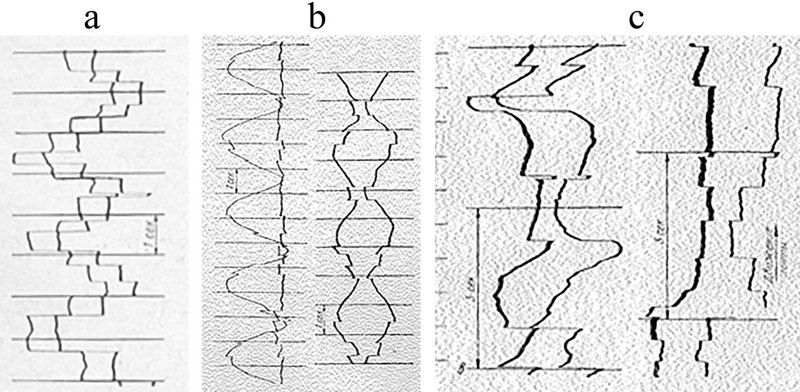For the first time, Alfred Yarbus described his technique for eye movement recording in 1954 in the Reports of the Academy of Sciences of the USSR (Doklady Akademii Nauk SSSR, XCVI (4): 733-735). At that time, his suction cap technique provided the best quality of records. It is remarkable that already in his first brief publication on eye movements Yarbus included the examples of binocular recordings accomplished by means of the two suction caps with miniature mirrors attached to both eyes.
Examples of eye movement patterns recorded by Yarbus in various conditions are given below. In the figure (a) with inserted scale and a schematic representation of the cone mosaic, it could be seen that random micro movements of the eyes in conditions of fixation, taking place when a subject was trying to look steadily at one and the same point, occupied a space of about 1° in diameter. Figure (b) is also related to the case of steady fixation of a point: the two curves represent horizontal components of the left and right eye movements. One could see that, in this case, drifts and micro saccades of the two eyes were highly correlated.

Figures 54 and 55 from Yarbus (1965).
Fixation of a stationary point for 30 s: (a) a monocular record of gaze movement around the fixation point; (b) horizontal components of the left and right eye movements during fixation recorded on a moving phototape.
The next figure shows the examples of various degrees of similarity and relative positions of the left and right eye movements.

Figures 56, 105, and 106 from Yarbus (1965).
Records of the left and right eye movements: (a) in the course of viewing a plane picture; (b) during pursuit of a pendulum oscillating in the subject’s sagittal plane passing through the right eye (left pair of records) and between the eyes (right pair of records); (c) while watching a fragment of stereo movie.
The two records obtained in the course of viewing a plane picture (a) demonstrate very high correlation similar to the case of steady fixation of one point. It is evident that, in the case of a plane picture, the eye tracks consist of the fragments corresponding to sequential fixation of different points and saccades between them. In the interesting cases of eye movements during pursuit of a pendulum oscillating in the sagittal plane, i.e. changing the distance to the subject (b), divergent and convergent phases are clearly seen and the influence of different positions of the pendulum in relation to the two eyes is well expressed.
The last two pairs of the eye tracking records are of special value since they were obtained in conditions of viewing stereo movie and perceiving virtual stereo images. It should be particularly emphasized that these records were obtained in 1955 when 3D techniques were relatively rare. It seems likely that Yarbus and his co-author Goltsman were the pioneer investigators who used eye tracking to study perception of stereo movies. The main problem was to avoid the necessity of wearing special stereo-glasses for the left-right image separation that hindered eye movement recording. Luckily, in the USSR there were two institutions — Institute of Biophysics in the Academy of Sciences of the USSR and the Research Institute of Cinematography and Photography – having stereo projection setups (with screens 1.2x1.2 m and 2.8x2.2 m, respectively) based on the lens raster technology that didn’t require glasses. Yarbus and Goltsman (1955) performed the experiments with stereo images in both these institutions. In particular, they compared eye positions while observing real and virtual objects in space and carried out a study of eye movements while watching a 3-D movie. However, they only performed pilot experiments: the records of the vergence eye movements were only used to confirm changing gaze position in depth (convergence and divergence of eye axes) in the cases when the virtual objects were approaching the observer or moving away from him. The investigations in this direction were not continued by Yarbus, probably because, at that time, there were few 3-D cinemas and few films for the masses. Nowadays, due to fast development of 3-D technologies and great progress in 3-D movie production, a lot of specialists in visual perception and 3-D techniques are involved in investigation of stereo images and providing better conditions for viewing 3-D movies and 3-D TV.
Chapters III-VI contain a lot of quantitative data and conclusions related to detailed description of different components and phases of the eye movements in different conditions. It is not strange that, later, some data and statements of Yarbus were refined or corrected due to development of more precise and powerful methods of investigation. On the contrary, it seems surprising that a majority of his findings remained valid up to the present day.